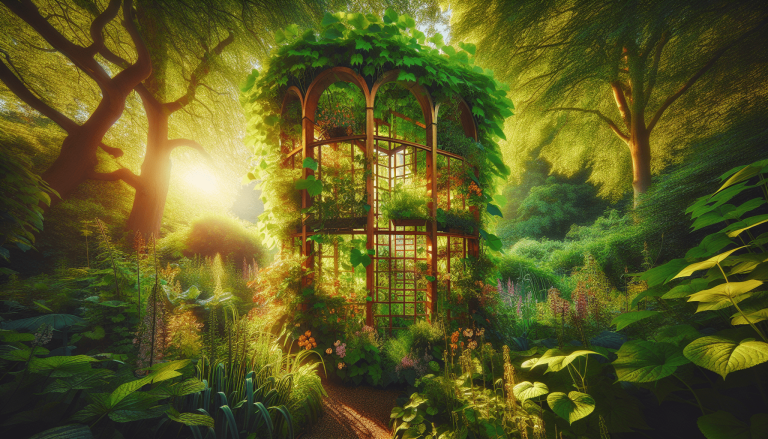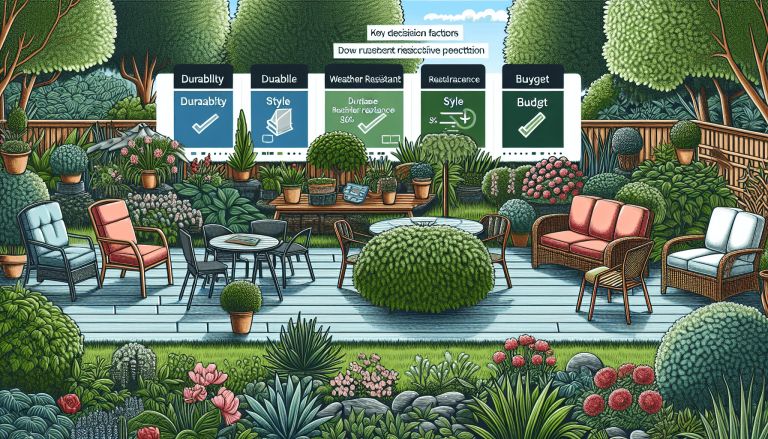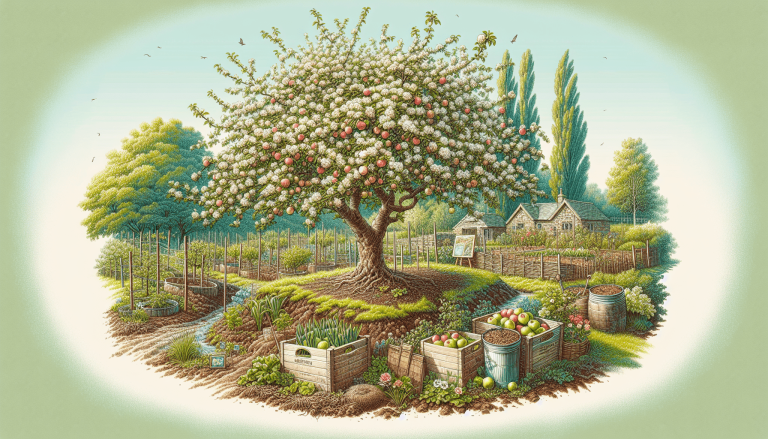Imagine transforming your backyard into a lush Mediterranean paradise right here in the UK. With its vibrant colors, aromatic plants, and serene ambiance, a Mediterranean-style garden is not just a dream escape, but a reality you can create. By carefully selecting the right plants, incorporating architectural elements, and paying attention to details like irrigation and soil composition, you can bring the sun-soaked beauty of the Mediterranean to your own little corner of the UK. So, roll up your sleeves, grab your gardening tools, and let’s embark on a journey to transform your outdoor space into a Mediterranean oasis that will transport you straight to the shores of Greece or Italy.
Table of Contents
ToggleChoosing the Right Location
Considering sunlight
When creating a Mediterranean-style garden, it is important to choose a location that receives ample sunlight. Mediterranean plants thrive in full sun, so make sure your chosen spot gets at least 6-8 hours of direct sunlight per day. This will ensure that your plants receive the warmth and light they need to flourish.
Assessing wind conditions
Another crucial factor to consider when selecting a location for your Mediterranean-style garden is wind conditions. Strong winds can damage delicate Mediterranean plants, so try to find a spot that offers some protection from the wind. This could be against a wall or fence, or in a naturally sheltered area of your garden.
Evaluating soil quality
Mediterranean plants are well-adapted to free-draining soil, so it is important to assess the quality of your soil before proceeding with your garden plans. If you have heavy clay soil, it may be beneficial to improve the drainage by incorporating organic matter such as compost or grit. This will help mimic the sandy, well-drained soil conditions found in Mediterranean regions.
Selecting Mediterranean Plants
Drought-tolerant plants
One of the key characteristics of Mediterranean gardens is their ability to withstand periods of drought. Therefore, it is essential to choose plants that are well-suited to dry conditions. Examples of drought-tolerant plants include lavender, rosemary, sage, and succulents like agave and yucca. These plants have adapted to survive in arid climates and will thrive in a Mediterranean-style garden.
Choosing aromatic herbs
Aromatics herbs are a staple in Mediterranean cuisine, and they also add a wonderful fragrance to your garden. Consider planting herbs such as thyme, oregano, basil, and mint. These not only provide a sensory delight but also enhance the authenticity of your Mediterranean garden.
Opting for citrus trees
Adding citrus trees to your Mediterranean-style garden can bring a touch of exoticism and provide delicious fruits to enjoy. Varieties like lemon, lime, and orange are well-suited to the UK climate with adequate protection during colder months. The vibrant colors of the citrus fruits will contribute to the Mediterranean color scheme and create a focal point in your garden.
Creating a Mediterranean Color Palette
Using warm and vibrant colors
To capture the essence of the Mediterranean, incorporate warm and vibrant colors into your garden. Think of hues like terracotta, deep yellows, fiery oranges, and vibrant reds. These colors mimic the warmth and intensity of the Mediterranean sun, instantly transforming your outdoor space into a Mediterranean oasis.
Incorporating shades of blue
Blue is another important color in a Mediterranean color palette. It reflects the hues of the Mediterranean Sea, creating a sense of calm and tranquility. Consider adding blue flowers such as agapanthus, delphiniums, or lavender to create striking visuals and evoke the serene beauty of the Mediterranean coast.
Adding pops of yellow
In addition to warm and vibrant colors, pops of yellow can help accentuate the Mediterranean feel in your garden. Bright yellow flowers like sunflowers, marigolds, and coreopsis can add a cheerful touch and create a visually appealing contrast against the lush greenery and other colors in your Mediterranean-style garden.
Integrating Mediterranean-style Structures
Installing a pergola or arbor
A pergola or arbor can serve as an architectural focal point in your Mediterranean-style garden. These structures provide shade, add vertical interest, and create an inviting space to relax and enjoy the outdoors. Consider growing climbing plants such as grapes, jasmine, or wisteria over the structure for a touch of Mediterranean charm.
Incorporating terracotta pots
Terracotta pots are a classic element of Mediterranean gardens. Their earthy tones and porous nature allow for proper drainage, which is ideal for Mediterranean plants. Arrange these pots strategically throughout your garden, filled with vibrant flowers or aromatic herbs, to add a traditional Mediterranean touch to your outdoor space.
Adding a water feature
Water features, such as a small fountain or a bubbling urn, can add a sense of tranquility and mimic the soothing sound of a Mediterranean coastal breeze. The presence of water in your garden can create an oasis-like ambiance and provide a refreshing element that is reminiscent of Mediterranean landscapes.
Designing with Mediterranean Features
Building raised beds
Raised beds not only add visual interest to your garden but also provide better drainage and aeration for your plants. They can be built using materials like natural stone or reclaimed wood to complement the Mediterranean aesthetic. Fill the raised beds with well-draining soil and plant colorful Mediterranean flowers or aromatic herbs to create an eye-catching display.
Incorporating stone pathways
Stone pathways are a common feature in Mediterranean gardens and can help guide visitors through your outdoor space. Use natural stone slabs or gravel to create meandering pathways, and consider adding some mosaic elements for an extra touch of Mediterranean flair. These pathways will enhance the charm and create a sense of exploration within your garden.
Creating a cozy seating area
A Mediterranean-style garden is meant to be enjoyed and shared with family and friends. Create a cozy seating area where you can relax and soak in the beauty of your garden. Choose comfortable outdoor furniture with wrought iron frames for an authentic Mediterranean look. Add colorful cushions and drape flowing fabrics to create a cozy and inviting atmosphere.
Implementing Sustainable Irrigation Methods
Installing a drip irrigation system
To achieve a sustainable Mediterranean-style garden, it is important to conserve water while still providing adequate hydration for your plants. Installing a drip irrigation system allows you to deliver water directly to the roots, minimizing evaporation and reducing water waste. This method ensures that your plants receive the moisture they need while promoting water efficiency.
Mulching and conserving water
Mulching is an effective technique for conserving water and suppressing weed growth. In a Mediterranean-style garden, use mulch made from organic materials like wood chips or straw to retain soil moisture. Mulch also provides insulation to plant roots and helps regulate soil temperature, thereby reducing the need for frequent watering.
Rainwater harvesting
Incorporating rainwater harvesting systems into your garden can further reduce your water consumption. Collecting rainwater in barrels or underground tanks allows you to use this precious resource during dry spells or for watering sensitive plants. Rainwater is naturally free of chemicals found in tap water, making it an ideal choice for irrigation in your sustainable Mediterranean-style garden.
Considering Mediterranean Garden Furnishings
Choosing wrought iron furniture
When it comes to Mediterranean garden furnishings, wrought iron is a popular choice. Its sturdy yet elegant design adds a touch of sophistication and authenticity to your outdoor space. Opt for wrought iron tables, chairs, and benches that complement the overall style of your garden. Consider adding colorful cushions or seat covers to enhance comfort and bring a pop of color to your seating area.
Opting for mosaic accents
Mosaic accents are a distinctive feature of Mediterranean gardens. They can be incorporated into tabletops, planters, or wall art to add intricate patterns and vibrant colors. Consider using brightly colored tiles to create mosaic designs on small surfaces, such as stepping stones or decorative pots, to infuse your garden with the rich artistic heritage of the Mediterranean.
Including terracotta ornaments
Terracotta ornaments are another traditional element of Mediterranean garden décor. From statues and pottery to decorative wall plaques, terracotta adds warmth and authenticity to your outdoor space. Place terracotta ornaments strategically throughout your garden to create focal points and evoke the rustic charm of Mediterranean landscapes.
Emphasizing Texture and Structure
Incorporating pebbles and gravel
Texture is an essential element of any Mediterranean-style garden. Incorporate pebbles and gravel into your design to add visual interest and mimic the rugged landscapes found in the Mediterranean region. Use them to create pathways, borders, or decorative areas. The combination of textured surfaces and vibrant plants will enhance the overall Mediterranean aesthetic of your garden.
Using cacti and succulents
Cacti and succulents are not only drought-tolerant but also add unique textures and shapes to your garden. Their spiky and fleshy structures create intriguing focal points within a Mediterranean-style design. Opt for varieties such as Agave, Aloe, or Echeveria, and arrange them in clusters or along borders to achieve a visually stunning composition.
Adding architectural plants
Architectural plants are characterized by their strong forms and striking silhouettes. Incorporating plants with architectural qualities, such as palms, yuccas, or olive trees, adds vertical interest and structure to your Mediterranean-style garden. These plants become focal points themselves, creating a dramatic and captivating visual impact.
Maintaining a Mediterranean-style Garden
Pruning and shaping plants
Regular pruning and shaping are essential for maintaining the aesthetic appeal of a Mediterranean-style garden. Trim back overgrown branches, remove dead foliage, and shape plants to maintain their desired form. This will ensure that your garden retains its neat and tidy appearance while promoting healthy growth.
Weeding and applying mulch
Weeding is an ongoing task in any garden, and it is especially important in a Mediterranean-style garden to prevent unwanted plants from competing for resources. Regularly inspect your garden for weeds and remove them promptly. Additionally, replenish mulch as needed to suppress weed growth and maintain moisture levels in the soil.
Providing winter protection
Winter weather can be harsh on Mediterranean plants in the UK. As such, it is important to provide proper winter protection to ensure their survival. Consider wrapping tender plants in horticultural fleece, providing shelter from strong winds, and insulating the root zone with mulch. These measures will help your plants withstand the colder temperatures and emerge strong and healthy in the spring.
Seeking Professional Advice
Consulting a garden designer
If you feel overwhelmed or unsure about creating your own Mediterranean-style garden, it may be beneficial to consult a garden designer. These professionals can provide expert advice tailored to your specific needs and help you design a garden that embodies the Mediterranean aesthetic while considering your local climate and unique garden characteristics.
Visiting Mediterranean-inspired gardens
Visiting Mediterranean-inspired gardens can be a great source of inspiration and ideas for your own garden. Observe the plant choices, layout, and design elements in these gardens to gain insight into how to create an authentic Mediterranean atmosphere. Pay attention to how different features are incorporated and take note of any design elements that resonate with your personal style.
Joining gardening communities
Joining gardening communities, both online and in-person, can be incredibly valuable when creating a Mediterranean-style garden. These communities often offer a wealth of knowledge, tips, and advice from experienced gardeners who have successfully cultivated Mediterranean-style gardens. Engaging in discussions, sharing experiences, and seeking guidance can help you overcome challenges and enhance your gardening journey.








